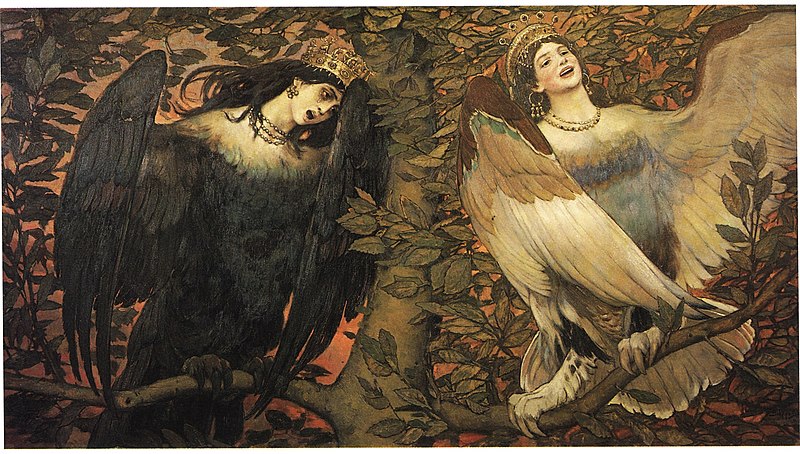
Viktor Vasnetsov. Sirin (left) and Alkonost (right) Birds of Joy and Sorrow. 1896. Oil on canvas 133*250 Russian Museum
Starlings are samplers. They pick up sounds from their environment and incorporate them into their calls, mixing and elaborating on top of a basic sound in order to create progressively longer strands of song. The males sing more than the females, and the story is that the longer the song, the more likely he is to attract a mate.
Starlings living with humans are a particularly strange auditory experience. I first noticed starlings imitating humans in a parking lot outside Austin, where the birds were doing the characteristic "boop boop!" of the electronic door openers from suburban minivans, along with a sound I was sure was the slamming of a car door.
Starlings are all over the internet, and this bird, whose name is Weeewoo, is a Youtube celebrity: there are lots of Weewoo videos, including this one in which he actually seems to be doing a call and response of sorts with his owner. Weewoo even has a myspace page which has a huge number of friends and a list of "Weewoo Facts" which include the following:
I talk all day long.
I learn a new word about every 2 months.
I go outside and fly around.
I am a free bird.
I can leave at anytime.
I sleep in a china bowl above the refrigerator.
I put myself to bed at night.
I get myself up in the mornings.
I take 3 or 4 baths a day.
If the TV is too loud when I go to bed, I "SQUAWK" until someone turns it down.
I eat all the bugs in the house.
The people who adopt starlings and write about it on the web all tell a version of the baby-on-the-doorstep story. They find the fat-mouthed baby bird defenseless and parentless and try unsuccessfully to reintroduce it to nature. Lots of wildlife rehabilitators won't take starlings because they are an invasive species- one starling owner says that their local animal shelter actually executes the baby starlings rather than nurse them back to health and life in the wild.

However it happens, people clearly love their starlings, and their love ends up integrated into the bird's call: every single domesticated starling I could listen to on the web said some version of "Gimme a Kiss." It can go bad, as in this video of a Russian girl attempting to kiss her starling Malutka, who gets a rather emphatic (and from the looks of it, deserved) rebuke.
The compelling thing about Starling talk is the way they pick up the tone of voice of the people they live with. Listen to Damar, below, whose mutterings and repeated vocalizations of his name suggest an entirely different kind of human house.
The strangest starling speech I heard is this one, which comes from this page. It's like the bird has been raised by care bears in Munchkinland.
There are yet to be stories of orphan babies being raised in the wild by starlings, but the musical aspect of the phenomenon goes both ways. This page has lots of examples of composers who use bird songs in their works, and it talks in particular about Mozart, who had a starling of his own.
Mozart seems to have admired his avian companion's musical skills. One of his notebooks records a passage from the last movement of the Piano Concerto in G Major and the same passage as the starling revised it. The bird imitated it closely but changed the sharps to flats. "Das war schön"—That was beautiful!,— reads the comment in Mozart's hand.When the starling died, Mozart held graveside ceremonies, singing hymns and reciting a poem he'd written for the fallen songster. Baptista agrees with two other ornithologists who have argued that Mozart's next composition, an odd sextet for strings and two horns, known as "A Musical Joke," shows starling style. Mozart wrote it only 8 days after the death of his bird, and it includes such starling-like bits as intertwined tunes, off-key recapitulations, and an abrupt ending.
Also, Baptista suggests new evidence for the starling's influence. He points out that starlings have the two-part syrinx, or voice organ, typical of songbirds and can belt out two songs at the same time. Baptista has even documented a starling simultaneously mimicking two birds—a grey fantail and a kelp gull—with the two sides of its syrinx. So, the final cadence of the sextet, essentially written in two keys played simultaneously, might honor the starling singing in two voices.

Oliver Messiaen, above, was a huge bird song fan. According to an article called Birdsong in Music by Trevor Hold ( Music & Letters, Vol. 52, No. 2. (Apr., 1971), pp. 113-122.), Messiaen dedicated "Reveil des Oiseaux" to a French ornithologist, a woman he knew, and to the "blackbirds, thrushes, nightingales, robins, chiffchaffs, blackcaps and all the birds of our woods."
The article disputes Messiaen's claims to have exactly relied on bird song, but also elaborates the extent to which Messiaen himself talked about stealing the songs of birds. In "Reveil des Oiseaux", Messiaen wrote in the preface, "There is nothing but bird songs in this work. All were heard in the forests and are perfectly authentic." The instrumental parts are based on the songs of specific birds, and the name of each bird is noted in the score below the instrument which represents it. Messiaen recommended that the pianist, in particular, should take walks in the woods to "get to know the original models" of the composition.
He wrote several compositions based on bird song, and the article quotes him saying,
It is in a spirit of no confidence in myself, or I mean in the human race, that I have taken bird-songs as a model. If you want symbols, let us go on to say that the bird is the symbol of freedom. We walk, he flies. We make war, he sings. Among birds most fights are settled by tournaments of song. Finally, despite my deep admiration for the folklore of the world, I doubt that one can find in any human music, however inspired, melodies and rhythms that have the sovereign freedom of bird-song.Some of the best images of starlings, though, are of the birds in flocks. I especially like this one, not least for the human voices that sit stupidly below the amazing flight of these invader birds. Swarming starlings suggest that the birds speak another language beyond their own and ours: a written language that can only occasionally be glimpsed in the flight of a flock.

No comments:
Post a Comment